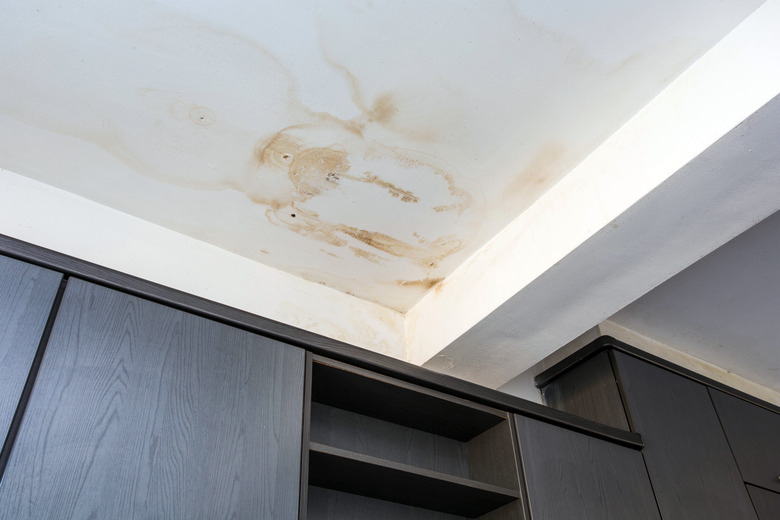What Causes Brown Spots On Ceilings?
We may receive a commission on purchases made from links.
Brown patches on the ceiling tend to be a warning sign of water damage. Usually, moisture has stained your ceiling, and it's a matter you'll need to get to the bottom of because it can worsen if it's ongoing. Whether it's leaking pipes, bad air circulation, or rambunctious kids in the tub, excessive moisture makes itself known through discoloration. Sometimes, the moisture causes mold, which is the stain. If the whole ceiling is brown, it may be years of cigarette smoke. Solutions depend on the cause.
Most Common Cause: Moisture Damage
Most Common Cause: Moisture Damage
Brown spots on the ceiling, which are usually the same color as tea, are typically the result of water damage. Unfortunately, the stain itself doesn't tell you how long moisture has been occurring or how serious the damage is. For that, you'll need to know the cause. Maybe your teen was blasting Imagine Dragons way too loud when the tub overflowed. That's quite the difference in remediation from a long-suffering, slow-leaking pipe hiding behind ceiling tiles.
If the moisture damage is from a storm or a leaking pipe, you'll need to get up behind the tiles or gypsum to investigate and fix whatever is going on. If it's a sudden or recent scenario, any affected wood and gypsum may dry out without any ill effect. The longer the moisture has been an issue, the more remediation may be needed in terms of replacing and patching any drywall, treating the wood, and so forth. Never leave potential leaks unresolved because the costs and consequences mount the longer it goes on.
If your problem is someone's sink- or tub-filling memory lapse that sent a river of water cascading all over the floor and down through the ceiling to the floor below, then odds are good that things will dry up without too much difficulty. If there's a lot of moisture, there may need to be airflow beyond the drywall or ceiling tiles in order to dry out. You may need to punch a small hole through the drywall and give it a week or two to dry out. Then, patch and paint that area later. It doesn't need to get expensive, though.
Other Culprits: Mold and Cigarette Smoke
Other Culprits: Mold and Cigarette Smoke
Mold can be caused by poor ventilation in a room that frequently has moisture, from saunas and bathrooms to kitchens. If moisture stays trapped, it condenses. If it only happens infrequently, the condensation dries out between incidents, but if it happens every time you cook, shower, or do the dishes, then it slowly stops drying out, and a mold stain may grow. While mold can be treated, mold will recur until you resolve the ventilation issues. Usually, mold is spotty or streaky black or green, though, and not brown.
A smoker's yellow ceiling shouldn't be a surprise to those who've caused the stain through their smoking, but maybe you've moved into a new home, and any previous smoking is a revelation to you. Moisture occurs in spots, but smoke will cause a yellowy-brown staining across the entire ceiling.
The good news is that you won't have any structural issues if it's merely a smoke-stained ceiling. The bad news is that it takes a lot of cleaning and scrubbing to get a smoke-stained ceiling clean, and you'll probably still want to paint it afterward. You will have to clean it first, though, so the paint won't discolor or peel. With good preparatory cleaning, any fresh paint will look fantastic.
